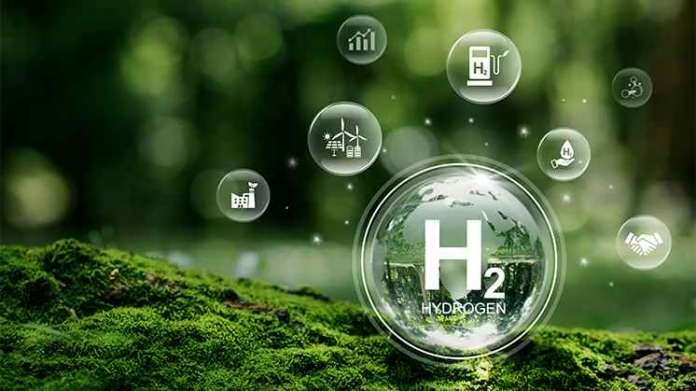Introduction
In a world facing climate change and rising energy demands, green hydrogen has emerged as a game-changer. Unlike traditional fuels, it offers a zero emission solution by using renewable electricity to split water molecules a process called electrolysis. The result? A clean, versatile fuel that could replace fossil fuels in critical sectors.

The International Energy Agency estimates that widespread green hydrogen use could eliminate 830 million tonnes of CO2 annually comparable to Germany’s emissions. This article explores how green hydrogen is produced, its environmental benefits, advantages, limitations, and how it’s already reshaping industries.
What is Green Hydrogen and How is it Produced?
Green hydrogen is hydrogen produced using electrolysis powered by renewable energy like wind or solar. Unlike grey or blue hydrogen, it doesn’t rely on fossil fuels or emit greenhouse gases.

Electrolysis process:
- Water is split into hydrogen and oxygen.
- Powered by clean electricity.
- The only byproduct is oxygen.
Major energy companies are investing heavily. For example, Iberdrola aims to produce 350,000 tonnes annually by 2030, signaling rapid industry growth.
Environmental Benefits and Climate Impact
Green hydrogen could play a major role in reducing global CO2 emissions. Replacing fossil-derived hydrogen could cut 830 million tonnes of CO2 per year.

Key environmental advantages:
- Zero emissions during production and use.
- Helps decarbonize hard to electrify sectors like steel, cement, and long-haul transport.
- Renewable electricity is the only input no depletion of natural resources.
Unlike fossil fuels, water used in electrolysis can be sustainably sourced. Even oxygen byproducts can be reused in other industries.
Advantages and Limitations
Advantages
- 100% Sustainable: No CO2 emissions; only water vapor.
- Energy Storage: Stores surplus renewable energy for later use.
- Versatile: Useful in transport, industry, and electricity generation.
- Energy Dense: 1 kg of hydrogen holds ~33.3 kWh 3x more than gasoline.
- Transportable: Can be shipped or piped globally.
Limitations
- High Cost: Currently 2–3x more expensive than grey hydrogen.
- Efficiency Loss: Electrolysis and storage reduce net energy yield.
- Infrastructure Needs: Transport and storage systems must be built.
- Safety: Hydrogen is flammable, requiring strict safety measures.
Despite these hurdles, costs are expected to drop by 50% by 2030, according to the World Hydrogen Council.
Types of hydrogen as a fuel
These methods of hydrogen production have resulted in a colour nomenclature that we use to refer to it and to how sustainable its extraction process has been. According to this colour scale, the main hydrogen types are:

Grey hydrogen
Grey hydrogen is obtained by reforming fossil fuels, with natural gas being the most common. It is currently the cheapest hydrogen to produce and the process emits a large amount of CO₂ into the atmosphere. It is also the type of hydrogen that is most commonly used today.
Blue hydrogen
Blue hydrogen is also obtained from fossil fuels, but with techniques capable of capturing and storing the CO₂ emissions produced. It is less polluting than grey hydrogen, but blue hydrogen is only capable of reducing emissions from its production process, not eliminating them completely.
Green hydrogen
Also called renewable hydrogen, green hydrogen is obtained by electrolysis of water. The most crucial thing is that this process is powered entirely by renewable energy, so it generates no polluting emissions into the atmosphere and is the cleanest and most sustainable hydrogen.
Real-World Applications
Green hydrogen is already powering innovations worldwide:
Energy Storage
- Balances electricity grids.
- Stores renewable energy during low-demand periods.
Industry
- Used in steel and ammonia production.
- Projects like Sweden’s HYBRIT aim to create fossil free steel.
Transport
- Hydrogen buses and trucks in Europe and Asia.
- Airbus and ZeroAvia exploring hydrogen powered aircraft.
Electricity & Heat
- Japan’s ENE-FARM program powers homes using hydrogen fuel cells.
- Large scale hydrogen plants emerging in South Korea and Germany.
Leaders
- Iberdrola: 60+ projects across 8 countries.
- Saudi Arabia: $5B NEOM project to export green hydrogen.

Conclusion
Green hydrogen is more than just a clean fuel it’s a pillar of the global clean energy transition. From reducing CO2 emissions to powering industry and transport, its potential is immense.
While challenges remain such as cost and infrastructure the future is promising. As technology advances and investments grow, green hydrogen could soon become a mainstream energy source.
Key takeaway: Supporting green hydrogen development today could mean a cleaner, more sustainable world tomorrow.
What excites you most about green hydrogen its environmental impact or technological promise?
Do you think your country is ready to invest in hydrogen infrastructure? Why or why not?
Related Articles:


